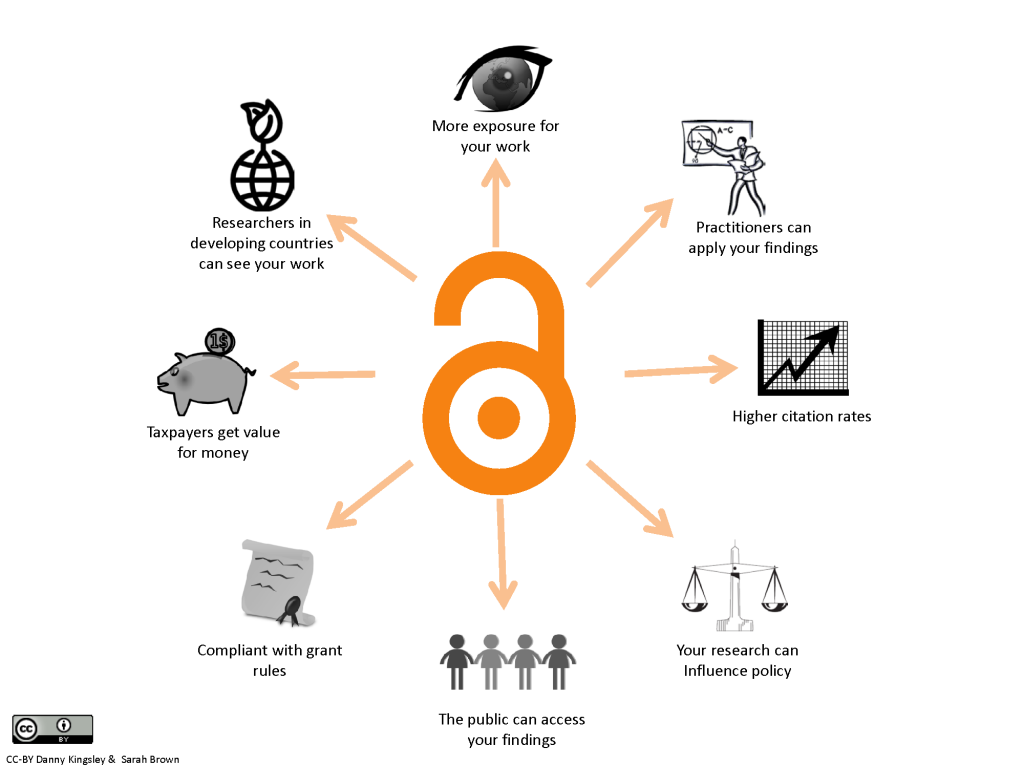On the first day of International Open Access week (#OAWeek, for those of you on Twitter), we wanted to take the opportunity to acknowledge the benefits of Open Access, outside of it being a requirement for the REF.
So, what is Open Access?
Open Access refers to material that is free to all readers at the point of access, so they can use and share it easily. There are two ‘routes’ to Open Access:
- Green OA: For Green Open Access you need to deposit a version of your work (usually the Author Accepted Manuscript) in a repository, such as the Kent Academic Repository (KAR), or a specialist subject repository. Copyright rules will often require there to be an embargo of 0-24 months (occasionally longer) but no payment will be required. Our REF Assisted Deposit service can help.
- Gold OA: The final, publisher-formatted version of your work (Publisher PDF) is made freely available via the Publishers website on publication, typically under a Creative Common licence. This usually (not always) requires the payment of an article processing charge (APC) or book processing charge (BPC). The University has funds available to pay these charges.
For further information on Open Access or the REF Assisted Deposit Service please visit the Research Support website or email researchsupport@kent.ac.uk
What has Open Access ever done for me?

OA opens up possibilities for knowledge to be used in unexpected, creative and innovative ways, far beyond the mainstream professional research.
Access to other researchers’ articles
Approximately 25% of articles are available Open Access. If you have ever read and used an Open Access article, or searched Wikimedia or Flikr or other sources for Creative Commons images to use in your teaching or research, you have benefitted from Open Access.
Researchers in the Developing World, practitioners, independent scholars and students who may not have access to a journal are able to view and access the work. It can be used by campaigners, charities and policy makers and may help them to make a real difference. It may be used by other researchers who can build on your findings to develop advancements. It cuts down on duplication of effort in research as peers can see what has already been studied. We’re fortunate to work at a University that has invested hugely in journal subscriptions, but many peers will not have access to these journals.
In terms of your work, what are the benefits?
Increased citation and usage
A number of studies have shown that open access articles are viewed more often than articles behind subscription paywalls and are cited more often. This makes good sense – it can be hard to get the essence of a paper from just the abstract and many readers will not want to pay £30+ for a few days’ worth of access.
There have been numerous studies that have found evidence of higher citations for Open Access articles. Gunther Eysenbach analysed Open Access and non-Open access articles published between June-December 2004 in the Proceedings of the National Academy of Sciences. Even accounting for confounding variables, he found that ‘even in a journal that is widely available in research libraries, OA articles [were] more immediately recognized and cited by peers than non-OA articles published in the same journal’ [Eysenbach, 2006, published in PLOS Biology].
Wang et al. found similar results for articles published open access in Nature Communications between 1 January 2012 and 31 August 2013. Open Access articles not only received higher total downloads and citations, but attracted a high number of downloads over a longer period when compared to non-open access articles [Wang et al.. 2015, published in Scientometrics – see Fig. 2 for an impressive visual illustration].
The Wellcome Trust also report that open access articles they have funded are downloaded 89% more when compared with access-controlled content.
Greater public engagement
Of the 20 most discussed journal articles of 2016 (Altmetric) I was able to click straight through to the full text of 18/20, so 90% (N.B.: Not all of these were published under Creative Commons, but all are freely available).
If you want the public to engage with your research they need to be able to access it. Others in Academia (at least in the Western World) will often have access to the institutional subscriptions required to read your article – but if you want your research to be read by the general public they need to be able to access it.
Faster impact
By opening up your publications other researchers are enabled to build on existing research more quickly – also cutting down on research duplication. Eysenbach‘s (2006; see above) 2004 study of open access and non-open access articles published in PNAS supported the view that open access accelerates the process by which researchers built upon existing research. Open access articles are cited earlier (and on average, more often) than non-open access articles. Again, this makes sense as many people that could be reading and citing your work may not have access to it on publication.
Wider collaboration
Open access publications and data enable researchers to carry out collaborative research on a global scale, with the Human Genome Project often cited as an example of the ability of open access to transform publications and data “into a much more powerful resource for research, education and innovation”. This international research project was enabled by the use of open data, with all sequence data made openly available for other researchers to use.
Increased interdisciplinary conversation
Interdisciplinary publications foster greater dialogue across disciplines, helping to find novel approaches to traditional problems. Open access journals that publish a broad range of research such as Nature Communications, Scientific Reports, Scientific Data and PLOS One help open up your research to a wider academic community.
Comply with funder mandates
Many funding bodies, including the Wellcome Trust, Leverhulme and the UK Research Councils amongst others, are increasingly requiring their grant holders to make articles stemming from the research freely available very shortly after publication. Many funders also require authors to publish under the CC-BY licence, with no restrictions on re-use (anyone using your work will still have to acknowledge the original resource). Increasingly, funders are also requiring the underlying data to be made freely available (check the policy of your funder here – please email us if you need any guidance).
Doesn’t Open Access mean someone can steal my work?
No – all of the Creative Commons licences require attribution, and you can restrict certain uses, such as commercial (choose CC-BY-NC), or limit the creation of derivatives (CC-BY-ND or CC-BY-NC-ND). Information on all of the licences, plus a link to the CC licence chooser tool, can be found on the Research Support pages here. Be aware that many funders specify which licence you must use (often CC-BY – the most open licence) so if you are funded do check restrictions, or contact us for advice.

